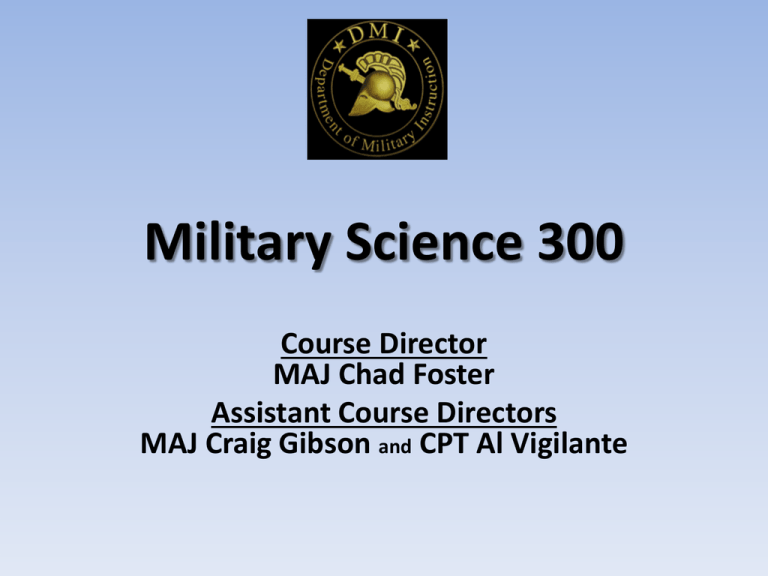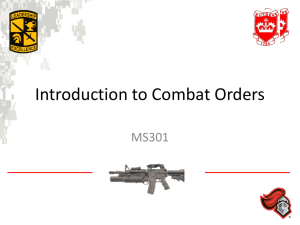MS300 09-02 Concept Brief
advertisement

Military Science 300 Course Director MAJ Chad Foster Assistant Course Directors MAJ Craig Gibson and CPT Al Vigilante Agenda What is MS300? Course Themes and Priorities References and Conceptual Foundation The Boyd Cycle MS300 Teaching Methodology Tactical Decision-Making Exercises Conceptual Emphasis Course Outcomes and Measures of Effectiveness AY 09-01 Course Layout How to Get to “Flexibility” What Is MS300? MS300 is the 3rd year military science course at the United States Military Academy It is one semester in length (40 lessons) and builds on the tactical decision-making and communication skills developed during previous Military Science Courses (MS100 and MS200) . . . The main difference between MS300 and the others is the level of complexity that the cadets must deal with in the scenarios. All ‘teaching’ is scenario-based . . . No PowerPoint presentations or lectures!!!! No rote memorization of information! The purpose of MS300 is to nurture adaptability, strength of character, effective communications skills, and decision-making MS300 is based on the principles of Outcomes-Based Training and Education (OBT&E) and uses the Adaptive Leader Methodology (ALM) as a guide for teaching. Course Themes and Priorities “Be willing to make decisions. That’s the most important quality in a leader.” “War is an art and as such is not susceptible to explanation by fixed formula.” - General George S. Patton, Jr. 1. The Worst Thing To Do Is To Make No Decision At All 2. There Is No Single, Scientific Solution To A Tactical Problem 3. It Is About “How To Think” Not “What To Think” 4. Communicate Effectively References and Conceptual Foundation The principles that underlie U.S. Army doctrine are the emphasis as we teach cadets “how to think.” Doctrine is not taught as “dogma.” The fundamental principles are understood as being the guide for future action. William S. Lind’s Maneuver Warfare Handbook provides inspiration and a conceptual basis for the themes and objectives of the course. Of particular importance are the concepts of enemy “surfaces and gaps,” mission orders, Schwerpunt, and Commander’s Intent. Donald E. Vandergriff’s Raising the Bar provides a “how to” blueprint for building a course based on the Adaptive Leader Methodology (ALM). The critical ‘step’ is Orientation! It is here that one makes sense of information, recognizes patterns, and formulates the “WHY” behind the subsequent decision. O Observation An individual “takes in” the information using all his senses. The Boyd Cycle O D Orientation He sorts through all the information and focuses on what is really important. He then ‘interprets’ that information within the context of the specific situation. Decision He uses the information that he ‘oriented’ on to make a decision. A Action He takes action in accordance with his decision(s). The “OODA Loop” is NOT a rigid process!!!! It is a model to illustrate how individuals think as they make decisions. It serves as the basic framework for teaching in MS300. MS300 Teaching Methodology TDE Formal Intro of ‘Theory’ or Doctrine OODA AAR Cadet Decision Experiential Learning (ALM) Brief / Defend Decision Before Peers and Instructor AAR Brief / Defend Decision Before Peers and Instructor Cadet Decision Change to Situation OODA Tactical Decision-Making Exercises (TDEs) Two Main Types: Immediate Decision TDE -Focus on rapid, immediate decision Planning TDE -Focus on timely, flexible COA development and clear communication -30 seconds to 1 minute allotted -2 min or more allotted -“Shoot” or “Don’t Shoot” situations *These shorter duration TDEs are well suited to ROE or escalation of force dilemmas - Culminates in briefing of an order (WARNO, OPORD, FRAGO) * Most of the “Planning TDEs” include “immediate decisions” during execution (usually prompted by changes to the situation) All scenarios are Platoon or Company-level and involve various types of units and weapon systems. By immersing the cadets in the scenario, we “teach” them about various weapons, types of operations, and Army branches without ever conducting a block of instruction or PowerPoint lecture! AY 09-02 Conceptual Emphasis Enemy “Surfaces and Gaps” Identification and avoidance of enemy strengths and identification and exploitation of enemy weaknesses Direct Fire Planning Application of principles of DFP and development of graphic control measures to help guide subordinates in accomplishment of desired ‘effect’ on enemy and avoid fratricide Integration of ‘Combat Multipliers’ Integration of indirect fires, aviation, UAV, PSYOPS, host nation security forces and other assets into tactical planning and problemsolving Communication of Orders Flexibility and Adaptability Utilizing various visual ‘tools’ to augment clarity of briefings; understanding the ‘why’ behind everything; clear and concise orders that answer the “so what?” for subordinates Understanding that “70 percent” is usually better than “90 percent” . . . Be ready for change and avoid overly complex and rigid plans Sample of MS300 Intended Outcomes and Measures of Effectiveness (1 of 3) MS300 employs the Adaptive Leader Methodology (ALM) as a guide for teaching, but the course is based on the philosophy of Outcomes-Based Training and Education (OBT&E) . . . Below are four of our most important intended outcomes along with their associated measures of effectiveness: Measures of Effectiveness Outcome: Cadets are able to go beyond mere regurgitation of information from higher HQ by effectively analyzing the enemy threat for an operation Cadets can estimate enemy strength, composition, and capabilities based on information and analysis from higher headquarters as well as their own common-sense and knowledge of the area Cadets can identify enemy weaknesses that can be exploited by friendly forces during an operation as well as enemy strengths that must be avoided or neutralized Cadets can formulate an educated guess about the enemy’s course of action based on that enemy’s capabilities, limitations, and past patterns as well as an understanding of the effects of terrain, weather and all other pertinent factors that in a given situation Cadets can explain why they believe the enemy will take the actions that they outline in the ECOA Cadets understand, and can explain, how an anticipated enemy COA is just a “best guess” and how that “best guess” is used as a starting point for tactical planning Sample of MS300 Intended Outcomes and Measures of Effectiveness (2 of 3) Outcome: Cadets are able to develop simple COAs that ensure unit of effort by their subordinates and adheres to the higher headquarters commander’s intent Cadets can clearly define a successful end-state for an operation that adheres to the higher headquarters commander’s intent Cadets can assign tasks to subordinates that make sense in terms of accomplishing their intended end-state for the operation Cadets can effectively “link” the efforts of their subordinates by explaining why each element is performing their assigned task and how that supports their overall plan Outcome: Cadets are flexible and adaptive tactical planners Cadets avoid focusing on only one possible enemy COA during planning Cadets develop COAs that are able to deal with multiple enemy threats while still remaining focused on accomplishment of the assigned mission Cadets can rapidly formulate and effectively communicate FRAGOs to their subordinates based on drastic changes in the tactical situation Sample of MS300 Intended Outcomes and Measures of Effectiveness (3 of 3) Outcome: Cadets are effective tactical communicators Cadets effectively integrate visual tools such as maps w/graphics, sketches and terrain models into their orders briefings as appropriate Subordinates come away from orders briefings understanding what it is that they are expected to do and why they are supposed to do it. Cadets provide subordinates with guidance that is clear enough to ensure unit of effort and adherence to the CDR’s intent but also flexible enough to allow subordinate leaders the ability to exercise initiative as the situation on the ground changes (provides clarity of guidance without micro-managing) MS 300 AY 09-02 Course Layout (40 Lessons) Adaptability, Strength of Character, Communication and Decision-Making COA Development and “Nesting” IPB and MA 1 6 12 COA Development and Direct Fire Planning 18 Integration of ‘Combat Multipliers’ 22 25 Platoon Mission Prep 27 28 29 In-Class TDE (Cadets in CO IPB DFP Assessment Teams) Assessment (100 pts) Company (100 pts) Graded TDE #1 WARNO (100 pts) Graded TDE #2 Issued Platoon (200 pts) WARNO (100 pts) CO OPORD Issued 33 39 40 Platoon OPORD Briefings (300 pts) Instructor Points Assigned (100 pts) How to Get to ‘Flexibility’ (The “House of Cards” Technique) 1 Have cadets develop COA based on very specific enemy intelligence . . . This is the ‘bait’ 2 Require cadets to ‘execute’ plan during a MAPEX or simulation With either the instructor or peer ‘role3 playing’ as the enemy, drastically alter the enemy situation. The cadets with plans that are rigidly tied to 4 one specific enemy COA will see their plans “fall apart” (like a house of cards will collapse when there is a slight change in the breeze). This allows for the emotional experience of a 5 ‘controlled failure,’ reinforcing the fact that “70% and flexible” is better than “90% and rigid.”



